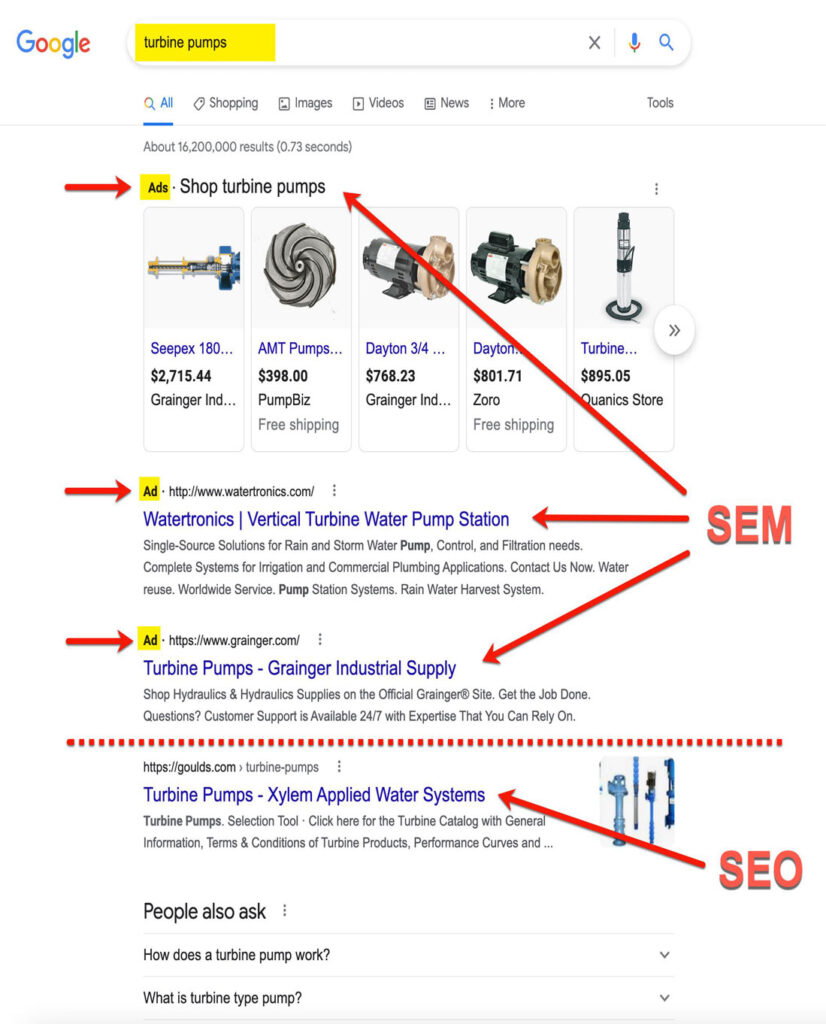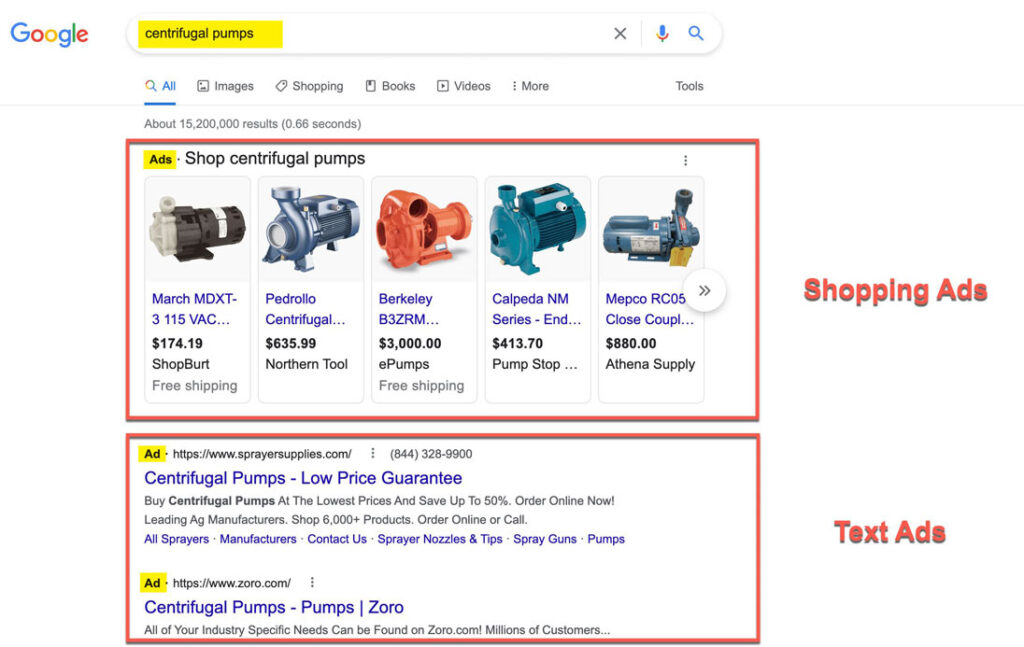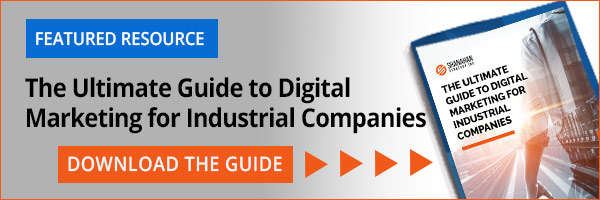Welcome to Part #2 of our series on How to Generate Leads. In Part #1, we discussed techniques for improving lead generation with your website. Lead generation is the process of attracting prospects to your business and increasing their interest through nurturing, all with the end goal of converting them into a customer. But what good does that do if you don’t have any traffic to your website? That’s where Search Engine Marketing or SEM can play a critical role in your lead generation strategy.
Ready to learn? Let’s dive in.
Key Takeaways:
- SEM can quickly improve reach and drive relevant traffic to your website
- SEM is also known as PPC (Pay Per Click) advertising on search engines
- SEM is often confused with SEO, but they’re separate strategies in digital marketing
- Google Ads is the most popular PPC platform for search engine marketing
What is SEM or Search Engine Marketing?
With SEM, marketers pay for ads to appear as search results on search engine results pages (SERPs), primarily Google and Bing in the U.S. They target keywords and phrases so that when a user searches for those terms or related terms, they’ll be shown an ad in the search results on Google or Bing. The beauty of search ads is that the advertiser is charged only if a user clicks on their ad.
Paid search ads can be found on almost any search results page. These paid placements are typically located at the top and bottom of the page. They include an “Ad” designation to let users know that it is a paid placement.
The most popular paid search platforms are Google Ads and Bing Ads, with Google holding a very dominant position based on their worldwide search engine market share.
Why is SEM Important?
Because a high percentage of buyers start their process with a Google search, search engine marketing has become a crucial online marketing strategy for increasing your company’s reach and driving relevant traffic to your website.
In fact, the majority of new visitors to a website find it by performing a query on a search engine, primarily Google in the U.S.
With search engine marketing, advertisers only pay for impressions that result in visitors (i.e., clicks), making it an efficient way for a company to spend its marketing dollars and drive meaningful results in terms of conversions… leads, orders, inquiries, downloads, subscriptions, registrations, etc.
Since buyers enter search queries with the intent of finding information of a commercial nature, they are in an excellent state of mind to make a purchase or some type of conversion, compared to other sites such as social media where users are not explicitly searching to make a purchase.
Search marketing frequently reaches buyers at exactly the right time: when they are open to new information and/or ready to make a purchase. Unlike the majority of digital advertising, PPC advertising is not as intrusive and does not interrupt their tasks.
Results are immediate with SEM. It is arguably one of the fastest ways to drive traffic and leads to your website.
What’s the Difference Between SEM and SEO?
Before you can start planning your strategy for improving your business’s online visibility, you need to understand the terminology and best practices. So let’s break this down into layman’s terms that are easy to understand. The two core areas within search marketing are:
- SEO (Search Engine Optimization) – An approach that uses organic methods to improve ranking and appear higher in search results (longer-term process with lasting organic (free) benefits). This approach includes on-page SEO and technical SEO designed to improve organic search engine ranking.
- SEM (Search Engine Marketing) – An approach that uses paid methods to appear in search results (quick results at a cost per click driving short-term results with few lasting benefits compared to SEO). This approach includes Pay-Per-Click ads such as Google search ads.
For most businesses, both SEO and SEM are important elements of their marketing strategy.
Pay Per Click (PPC): Google Search Ads
Using paid search or pay per click (PPC) search ads is one of the quickest ways to bring targeted traffic to your website. PPC can be very effective, but it’s also a complex process and can get expensive, which may not be sustainable for your business. For this reason, smart businesses leverage an individual or agency with extensive PPC experience and knowledge of the business.
Google holds the majority share of all searches for most of the world. Get in on the action by using Google Ads to drive active buyers right to a relevant landing page for your business. The second-tier option is Bing Ads, but you’ll likely find the best platform is Google Ads due to their sheer dominance of all search engines and the PPC ad space.
More resources on Google Ads:
- 8 Steps to Prepare Your Campaign for Success
- Google Ads Best Practices
- Glossary of Common Terms related to Google Ads
What is the Simple Definition of Cost-Per-Click (aka PPC)?
Cost-per-click (CPC) bidding means that you pay for each click on your ads. For CPC bidding campaigns, you set a maximum cost-per-click bid – or simply “max. CPC” – that’s the highest amount that you’re willing to pay for a click on your ad (unless you’re setting bid adjustments, or using Enhanced CPC).
Your maximum CPC is the most you’ll typically be charged for a click, but you’ll often be charged less — sometimes much less. That final amount you’re charged for a click is called your actual CPC.
The position of your ad on the search results page is based on many factors, including your bid amount, keywords, ad quality, and ad relevance. This entire auction process takes milliseconds to occur during each and every Google search.

What is the “Ad Auction” in Terms of Google Ads?
The process that happens with each Google search to decide which ads will appear for that specific search and in which order those ads will show on the page (or whether or not any ads will show at all). Each time an ad is eligible to appear for a search, it goes through the ad auction. The auction determines whether or not the ad actually shows and in which ad position it will show on the page.
Here’s how the auction works:
- When someone searches Google, the Google Ads system finds all ads whose keywords match that search.
- From those ads, the system ignores any that aren’t eligible, like ads that target a different country or are disapproved based on a policy violation.
- Of the remaining ads, only those with a sufficiently high Ad Rank may show. Ad Rank is a combination of your bid, ad quality, the context of the person’s search, and the expected impact of extensions and other ad formats.
The most important thing to remember is that even if your competition bids higher than you, you can still win a higher position — at a lower price — with highly relevant keywords and ads.
Since the auction process is repeated for every search on Google, each auction can have potentially different results depending on the competition at that moment. Therefore it’s normal for you to see some fluctuation in your ad’s position on the page and in whether or not your ad shows at all.
Where do Google Shopping Ads fit into SEM?
If you’re a retailer or sell direct to businesses, you can use Google Shopping campaigns to promote your online and local inventory, boost traffic to your website or local store, and find more qualified leads.
To get started, you’ll send Google your product data via Google’s Merchant Center and create a campaign in Google Ads. Then, we’ll use your campaign to create ads on Google and around the web where potential customers can see what you’re selling based on their searches. We call these placements Shopping ads because they appear in a different, more visual format. In contrast to a text ad, which displays text only, Shopping ads show users a photo of your product, plus a title, price, store name, and more. These ads give users a strong sense of the product you’re selling before they click the ad, which gives you more qualified leads.

Just like other ad formats, your Shopping ads participate in an ad auction. You’re charged using a cost-per-click (CPC) model, which is when someone clicks your ad. So, you’re charged only when someone clicks an ad that leads to the landing page on your website or to the Google-hosted landing page for your local inventory.
When you’re creating your Shopping campaign, you’ll decide how much you’re willing to pay for each click. You’ll only pay the minimum amount necessary to rank higher than the advertiser immediately below you, and you’ll often pay less than your maximum bid.
Does Google Offer More than Just Search Ads?
Yes. Google offers a wide range of different ad types. Depending on your goals and other factors, search ads are typically used in combination with other ad types on Google and other platforms.
- Search ads – Text ads on Google search results
- Display ads – Image ads on websites
- Video ads – Video ads on YouTube
- Shopping ads – Product listings ads on Google search results
- App ads – App promotion on many channels
What are Remarketing Ads?
Although not considered part of SEM, Remarketing (aka Retargeting) ads are display ads that re-target previous website visitors, and positions display ads while visitors browse elsewhere around the internet or use apps. This can be an ingenious way to remind a specific buyer about their visit to your site, and why they should come back. Google, Facebook, Instagram, and others offer retargeting ad programs that have been proven to be extremely effective when properly executed.
Where do Paid Social Media Ads Fit?
Another segment not considered part of SEM is paid ads on social media platforms like Facebook, LinkedIn, Instagram, and Twitter. Each platform offers different advertising options but simply put, they provide a means to promote featured content to a targeted group.
The advantage of social platforms like Facebook and LinkedIn is they offer very specific targeting tools (age, gender, location, job title, interests, employer, industry, website visits, etc.). However, the efficacy of paid social ads depends on your business and your ideal buyer. Your target audience must be active on the platform to reach them, so make sure you do your homework before jumping in and start small with lots of testing and good analytics.
Is Programmatic Advertising Part of SEM?
No, primarily because it’s not initiated by a user’s search. Programmatic advertising refers to buying and selling ad inventory in real-time, using auction-based software rather than manual negotiations. This gives an advertiser the ability to pay for ad impressions based on the value of the eyeballs viewing their ad instead of a flat CPM (cost per 1,000 impressions) across all impressions on a website.
Google Display ads are considered a type of programmatic advertising because both systems are auction-based and use display advertising to reach a specific audience.
Although programmatic advertising isn’t considered part of SEM, it certainly has a place and can drive positive results as a part of your overall marketing strategy.
Wrapping Up
Any successful leadership team should always start with an overall marketing strategy for your business. SEM and SEO should definitely be a component of any successful strategy, but the execution should be done with purpose and not in the form of random acts. If you need help with creating and executing a lead generation strategy including SEM and SEO, get in touch with Shanahan Strategy to schedule a consultation.

